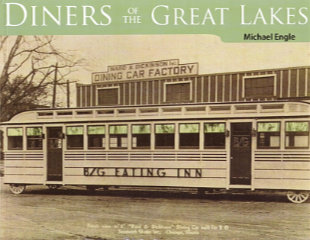 My original notion of what’s inside Diners of the Great Lakes was not very accurate, but I’m not the least bit disappointed. For no particular reason, I more or less expected this book to be something akin to a directory of diners currently existing in the Great Lakes region along with a telling of their individual histories. There is a certain amount of that, but it comes late in the book after Engle has delivered not just the history of diner operation in the region but of the manufacture of diners there along with their development as something distinct from what occurred nearer the Atlantic.
My original notion of what’s inside Diners of the Great Lakes was not very accurate, but I’m not the least bit disappointed. For no particular reason, I more or less expected this book to be something akin to a directory of diners currently existing in the Great Lakes region along with a telling of their individual histories. There is a certain amount of that, but it comes late in the book after Engle has delivered not just the history of diner operation in the region but of the manufacture of diners there along with their development as something distinct from what occurred nearer the Atlantic.
The industrial revolution of the late nineteenth century was accompanied by a revolution in food sales. Factories might now operate around the clock and their employees needed to be fed quickly and at non-traditional times. At first, food prepared at home would be sold from a pushcart, but it wasn’t too long before larger wagons containing elementary kitchens appeared. Simple freshly prepared items were sold to hungry workers and others through windows. As the twentieth century rolled in, larger horse-drawn wagons, with inside seating for a few patrons became common. The earliest lunch carts were naturally built by their operators. Eventually, however, manufacturers, such as Closson Lunch Wagon Company of Westfield, NY, began constructing wagons to sell. Engle illustrates the development of lunch wagons and the stationary diners that followed them, with wonderful period photographs, advertisements, and newspaper clippings.
As the story progresses from Closson’s horse-drawn wooden wagons through large built-on-site chrome Starlites, I found it interesting how the nomenclature changed slowly from lunch wagon to dining car to diner. I also found it personally interesting to learn that diners had once been manufactured in my home state of Ohio including some in nearby Dayton.
The book ends with what I once thought might fill the whole thing. The “Great Lakes Diner Directory” contains an extensive listing of diners with photos, descriptions, and locations. As Engle points out, assuring that the list is absolutely complete and current is impossible. The region’s diner population, like that everywhere else, is dynamic. “Call before you go,” is certainly good advice but the list in this book is as good as it gets.
Diners of the Great Lakes, Michael Engle, Michael Engle Publishing, November 1, 2018, 8.5 x 11 inches, 322 pages, ISBN 978-0976938927
Available through Amazon.

Definitely picking this up the next time I head up to Michigan.
Yeah, I think you’d like this. About 20 listed in Michigan though not all operating.